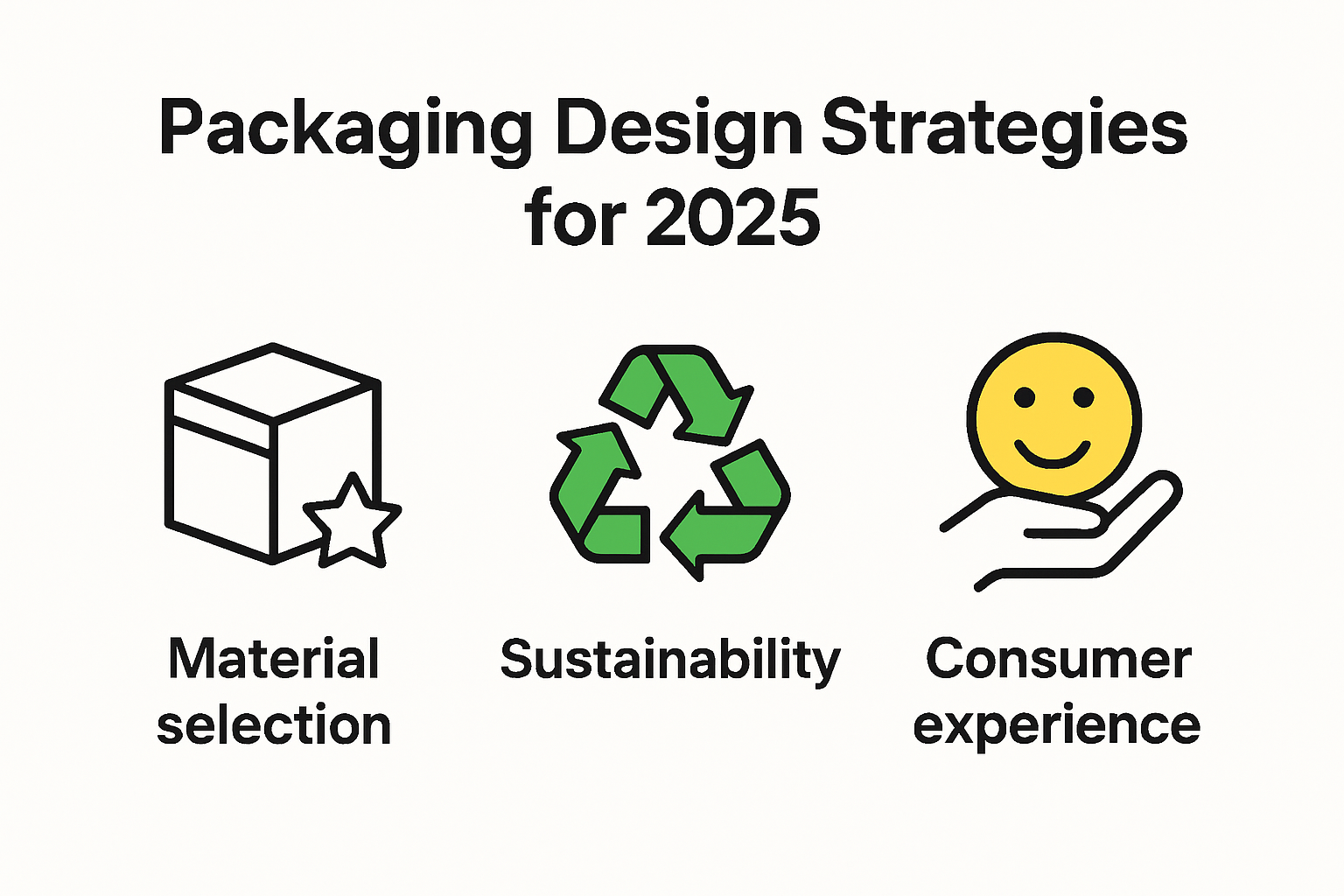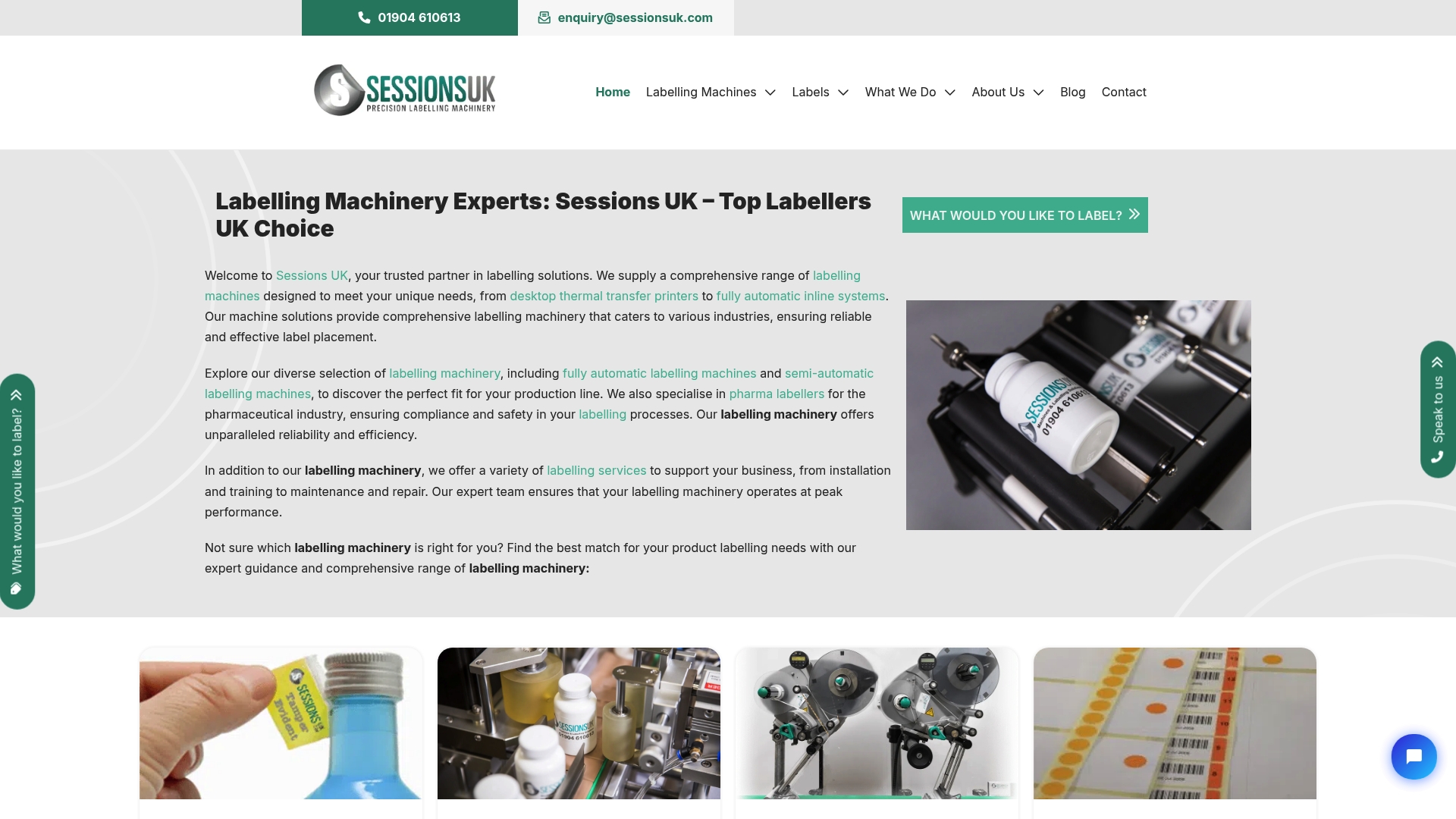
Packaging is no longer just about wrapping something up. Companies in 2025 are now treating packaging as a tool that shapes customer loyalty, cost savings and environmental performance. Here’s something that might surprise you. Switching to optimised packaging dimensions has been shown to significantly slash both material use and transportation costs. Most think innovation stops at recycling logos and new colours. In reality, those leading the pack are turning every box and bottle into a strategic asset, blending science, sustainability and smart design in ways the competition never saw coming.
| Takeaway | Explanation |
|---|---|
| Strategic Material Selection is Key | Intelligent material choices that balance performance, cost, and environmental impact are crucial for effective packaging design in 2025. |
| Embrace Sustainability and Circular Design | Incorporate minimalist designs, recyclability, and material traceability to enhance lifecycle planning and environmental responsibility. |
| Focus on Consumer Experience | Design packaging that effectively communicates brand values and provides an engaging user experience, considering ergonomics and sensory appeal. |
| Innovate While Ensuring Performance | Packaging must deliver equivalent or superior functionality to traditional materials, requiring a multidisciplinary approach integrating various fields of expertise. |
| Integrate Compliance and Safety Measures | Adhere to stringent regulations and ensure product safety through adequate testing and clear hazard communication, especially for regulated industries. |

Packaging design represents a critical intersection of functionality, brand communication, and sustainability for industry leaders in 2025. Modern packaging strategies go far beyond mere product protection, transforming into strategic tools that drive consumer engagement, operational efficiency, and environmental responsibility.
The foundation of effective packaging design begins with intelligent material selection. According to the UK Research and Innovation’s Smart Sustainable Plastic Packaging (SSPP) Challenge, manufacturers must prioritize materials that balance performance, cost, and environmental impact. This approach requires a nuanced understanding of material properties and their long-term implications.
Modern packaging materials are no longer simple containers but sophisticated solutions that interact dynamically with products. For instance, advanced polymers and bio-based materials can now provide enhanced barrier properties, extended shelf life, and reduced environmental footprint. Explore our guide on innovative packaging solutions to understand how material science is revolutionising product packaging.
Environmental considerations have transitioned from optional strategies to mandatory business practices. The UK government’s PackUK interim strategy emphasises reducing unnecessary packaging and increasing material circularity. This means designing packaging with its entire lifecycle in mind—from initial production through potential reuse or responsible disposal.
Circular design principles require manufacturers to think holistically about packaging. Key considerations include:

Packaging has evolved into a powerful communication medium. Beyond protecting products, it now serves as a direct interface between brands and consumers. Effective packaging design communicates brand values, provides critical product information, and creates memorable unboxing experiences.
Advanced packaging strategies incorporate user-centric design principles that consider ergonomics, accessibility, and sensory engagement. This means developing packaging that is not just visually appealing but also intuitive to open, handle, and dispose of responsibly.
The most successful packaging designs in 2025 will seamlessly integrate technical performance, environmental consciousness, and compelling brand storytelling. By adopting holistic strategies that balance innovation, sustainability, and user experience, industry leaders can transform packaging from a passive container into an active component of their business strategy.
The intersection of innovation and sustainability in packaging represents a critical frontier for industry leaders in 2025, demanding sophisticated approaches that balance technological advancement with environmental responsibility. As global challenges intensify, packaging strategies must evolve beyond traditional paradigms to create meaningful solutions that address both business needs and ecological imperatives.
Cutting-edge material science is driving transformative changes in packaging design. According to the University of Sheffield’s BUDDIE-PACK project, emerging research focuses on developing reusable packaging technologies that dramatically reduce waste and resource consumption. These innovations go beyond conventional recycling, exploring molecular-level design that enables complete material regeneration.
Advanced bio-based materials are emerging as game-changers in sustainable packaging. Researchers are developing polymers derived from agricultural waste, algae, and other renewable sources that offer comparable performance to traditional plastics while significantly reducing carbon footprints. Learn more about breakthrough packaging materials to understand how these technologies are reshaping industry standards.
The Retail Institute’s “Future of Packaging 2025” report emphasises that sustainability requires a holistic, collaborative approach. This means moving beyond isolated initiatives to create interconnected systems that support comprehensive waste reduction and material reuse.
Key strategies for implementing circular economy principles include:
Innovation in packaging cannot compromise product protection or performance. The UK Research and Innovation’s Smart Sustainable Plastic Packaging Challenge highlights that truly sustainable packaging must deliver equivalent or superior functional characteristics compared to traditional materials.
This requires a multidisciplinary approach integrating material science, engineering, environmental research, and user experience design. Manufacturers must develop packaging that is not just environmentally responsible but also technically superior, providing enhanced protection, longer shelf life, and improved user interactions.
As we progress through 2025, the most successful packaging strategies will be those that seamlessly integrate technological innovation, environmental stewardship, and exceptional product performance. By embracing a comprehensive approach that considers entire ecosystem impacts, industry leaders can transform packaging from a potential environmental liability into a powerful tool for sustainable development.
Here is a summary table outlining the main strategies and principles involved in circular design for packaging, enhancing clarity for readers:
| Principle/Strategy | Description |
|---|---|
| Minimalist Design | Reducing material usage without loss of product protection |
| Recyclability | Ensuring packaging can be reprocessed and reintegrated |
| Material Traceability | Transparent supply chains for material tracking |
| Collaborative Design | Involving multiple stakeholders in sustainable solutions |
| Advanced Tracking | Using digital tools to monitor packaging lifecycles |
| Closed-Loop Systems | Enabling full recovery and reuse of materials |
Packaging design has transformed from a mere protective function to a strategic lever for operational efficiency and cost management. In 2025, industry leaders recognize that intelligent packaging strategies can significantly reduce supply chain expenses while simultaneously enhancing product value and brand performance.
According to research from Packaging Gateway, optimising packaging dimensions can dramatically reduce material consumption and transportation costs. Precise engineering of packaging dimensions enables manufacturers to minimise unused space, decrease shipping volumes, and reduce overall logistics expenditure.
Strategic material selection plays a crucial role in cost efficiency. Lightweight materials that maintain structural integrity can reduce shipping weights, translating directly into fuel savings and lower transportation expenses. Explore our comprehensive guide on efficient packaging solutions to understand how material innovations can drive substantial cost reductions.
The Packaging Strategies report highlights that standardising packaging designs across product lines facilitates significant economies of scale. By developing modular packaging systems, companies can streamline production processes, reduce tooling costs, and create more flexible manufacturing environments.
Key advantages of packaging standardisation include:
Contrary to traditional perceptions, sustainable packaging can be a powerful cost-efficiency tool. Research from MDPI Sustainability Journal demonstrates that implementing recyclable materials and reducing packaging size not only minimises environmental impact but also generates substantial economic benefits.
Advanced packaging design strategies in 2025 integrate sustainability with cost management. This involves:
Successful organisations understand that cost efficiency is no longer about reducing expenses but about creating intelligent, adaptable packaging systems. By combining technological innovation, strategic material selection, and a holistic view of supply chain dynamics, industry leaders can transform packaging from a cost centre into a strategic asset that drives operational excellence and competitive advantage.
The table below presents a comparison of key cost efficiency strategies in packaging and their specific supply chain benefits:
| Strategy | Supply Chain Benefits |
|---|---|
| Optimised Packaging Dimensions | Lower material use, reduced shipping volumes, cost savings |
| Strategic Material Selection | Lighter packages, reduced transport costs, fuel savings |
| Standardisation and Modularity | Inventory simplification, economies of scale, flexibility |
| Sustainable Packaging Implementation | Lower waste management costs, economic and environmental gains |
In regulated industries, packaging design transcends aesthetic and functional considerations, becoming a critical mechanism for ensuring product safety, legal compliance, and consumer protection. As regulatory landscapes become increasingly complex, industry leaders must develop sophisticated packaging strategies that meet stringent standards across multiple domains.
According to the UK Health and Safety Executive, packaging for regulated products must satisfy multiple critical parameters. Manufacturers must ensure packaging prevents chemical escape, resists potential damage, and maintains structural integrity during normal handling processes. This demands a comprehensive approach that integrates material science, engineering precision, and rigorous testing protocols.
For hazardous materials and chemicals, packaging requirements become even more intricate. Specific regulations mandate features such as child-resistant closures, tactile warning signals for visually impaired users, and robust sealing mechanisms that prevent accidental contamination or exposure. Check our comprehensive guide to safety labelling requirements to understand the nuanced compliance landscape.
The UK Government’s Product Safety Compliance Guidelines emphasise manufacturers’ responsibility to ensure product safety before market placement. This involves conducting thorough conformity assessments, implementing appropriate safety markings, and providing comprehensive consumer information.
Key compliance considerations include:
For industries dealing with dangerous goods, packaging must meet international transportation standards. The Health and Safety Executive’s Dangerous Goods Transportation Guidelines require packaging to undergo rigorous UN certification processes, involving extensive testing to validate suitability for transporting hazardous materials.
International compliance demands a multifaceted approach that considers:
Successful packaging design in regulated industries represents a delicate balance between innovation, safety, and regulatory adherence. By adopting a holistic approach that integrates advanced materials, sophisticated engineering, and comprehensive safety protocols, manufacturers can develop packaging solutions that not only meet but exceed complex regulatory requirements while protecting consumer interests.
The key strategies include strategic material selection, embracing sustainability and circular design principles, focusing on consumer experience, and integrating compliance and safety measures.
Effective packaging communicates brand values and provides engaging user experiences by incorporating ergonomic design, accessibility, and sensory appeal, ensuring that the packaging both captivates and informs the consumer.
Sustainability is essential as businesses face increased pressure to reduce their environmental impact. Incorporating sustainable materials and circular design practices can enhance a brand’s reputation and comply with regulatory requirements.
Compliance ensures that packaging meets legal safety standards and regulatory requirements, which is vital for product safety and consumer protection, particularly for hazardous materials and chemicals.
The article highlights a common industry challenge for 2025: the need to turn advanced packaging design strategies into practical gains like operational efficiency, improved compliance, and consumer trust. Too often, businesses struggle to translate sustainability targets or optimised packaging dimensions into production line realities. Precision and consistency are not optional – they are essential for reducing costs, avoiding errors, and safeguarding your brand’s reputation. Sessions UK understands that packaging innovation only delivers results when every component, especially labelling, is reliable and accurate.
Explore our Labelling Machines

Ready to close the gap between strategy and streamlined production? Discover how the right labelling equipment can accelerate your move towards flawless, compliant packaging. Visit https://sessionsuk.com today for expert support, or browse our fully automatic solutions to take the next step towards packaging leadership.
Copyright © 2025 Sessions Label Solutions Ltd.